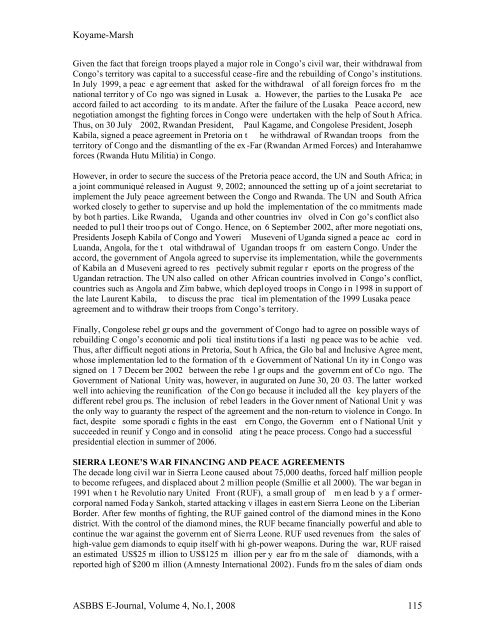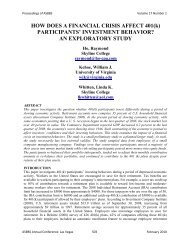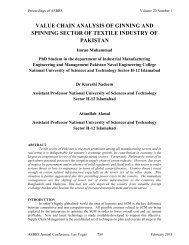stock repurchase announcements: a test of market ... - Asbbs.org
stock repurchase announcements: a test of market ... - Asbbs.org
stock repurchase announcements: a test of market ... - Asbbs.org
Create successful ePaper yourself
Turn your PDF publications into a flip-book with our unique Google optimized e-Paper software.
Koyame-Marsh<br />
Given the fact that foreign troops played a major role in Congo’s civil war, their withdrawal from<br />
Congo’s territory was capital to a successful cease-fire and the rebuilding <strong>of</strong> Congo’s institutions.<br />
In July 1999, a peac e agr eement that asked for the withdrawal <strong>of</strong> all foreign forces fro m the<br />
national territor y <strong>of</strong> Co ngo was signed in Lusak a. However, the parties to the Lusaka Pe ace<br />
accord failed to act according to its m andate. After the failure <strong>of</strong> the Lusaka Peace accord, new<br />
negotiation amongst the fighting forces in Congo were undertaken with the help <strong>of</strong> Sout h Africa.<br />
Thus, on 30 July 2002, Rwandan President, Paul Kagame, and Congolese President, Joseph<br />
Kabila, signed a peace agreement in Pretoria on t he withdrawal <strong>of</strong> Rwandan troops from the<br />
territory <strong>of</strong> Congo and the dismantling <strong>of</strong> the ex -Far (Rwandan Armed Forces) and Interahamwe<br />
forces (Rwanda Hutu Militia) in Congo.<br />
However, in order to secure the success <strong>of</strong> the Pretoria peace accord, the UN and South Africa; in<br />
a joint communiqué released in August 9, 2002; announced the setting up <strong>of</strong> a joint secretariat to<br />
implement the July peace agreement between the Congo and Rwanda. The UN and South Africa<br />
worked closely to gether to supervise and up hold the implementation <strong>of</strong> the co mmitments made<br />
by bot h parties. Like Rwanda, Uganda and other countries inv olved in Con go’s conflict also<br />
needed to pul l their troo ps out <strong>of</strong> Congo. Hence, on 6 September 2002, after more negotiati ons,<br />
Presidents Joseph Kabila <strong>of</strong> Congo and Yoweri Museveni <strong>of</strong> Uganda signed a peace ac cord in<br />
Luanda, Angola, for the t otal withdrawal <strong>of</strong> Ugandan troops fr om eastern Congo. Under the<br />
accord, the government <strong>of</strong> Angola agreed to supervise its implementation, while the governments<br />
<strong>of</strong> Kabila an d Museveni agreed to res pectively submit regular r eports on the progress <strong>of</strong> the<br />
Ugandan retraction. The UN also called on other African countries involved in Congo’s conflict,<br />
countries such as Angola and Zim babwe, which deployed troops in Congo i n 1998 in support <strong>of</strong><br />
the late Laurent Kabila, to discuss the prac tical im plementation <strong>of</strong> the 1999 Lusaka peace<br />
agreement and to withdraw their troops from Congo’s territory.<br />
Finally, Congolese rebel gr oups and the government <strong>of</strong> Congo had to agree on possible ways <strong>of</strong><br />
rebuilding C ongo’s economic and poli tical institu tions if a lasti ng peace was to be achie ved.<br />
Thus, after difficult negoti ations in Pretoria, Sout h Africa, the Glo bal and Inclusive Agree ment,<br />
whose implementation led to the formation <strong>of</strong> th e Government <strong>of</strong> National Un ity in Congo was<br />
signed on 1 7 Decem ber 2002 between the rebe l gr oups and the governm ent <strong>of</strong> Co ngo. The<br />
Government <strong>of</strong> National Unity was, however, in augurated on June 30, 20 03. The latter worked<br />
well into achieving the reunification <strong>of</strong> the Con go because it included all the key players <strong>of</strong> the<br />
different rebel grou ps. The inclusion <strong>of</strong> rebel leaders in the Gover nment <strong>of</strong> National Unit y was<br />
the only way to guaranty the respect <strong>of</strong> the agreement and the non-return to violence in Congo. In<br />
fact, despite some sporadi c fights in the east ern Congo, the Governm ent o f National Unit y<br />
succeeded in reunif y Congo and in consolid ating t he peace process. Congo had a successful<br />
presidential election in summer <strong>of</strong> 2006.<br />
SIERRA LEONE’S WAR FINANCING AND PEACE AGREEMENTS<br />
The decade long civil war in Sierra Leone caused about 75,000 deaths, forced half million people<br />
to become refugees, and displaced about 2 million people (Smillie et all 2000). The war began in<br />
1991 when t he Revolutio nary United Front (RUF), a small group <strong>of</strong> m en lead b y a f ormercorporal<br />
named Foday Sankoh, started attacking v illages in eastern Sierra Leone on the Liberian<br />
Border. After few months <strong>of</strong> fighting, the RUF gained control <strong>of</strong> the diamond mines in the Kono<br />
district. With the control <strong>of</strong> the diamond mines, the RUF became financially powerful and able to<br />
continue the war against the governm ent <strong>of</strong> Sierra Leone. RUF used revenues from the sales <strong>of</strong><br />
high-value gem diamonds to equip itself with hi gh-power weapons. During the war, RUF raised<br />
an estimated US$25 m illion to US$125 m illion per y ear fro m the sale <strong>of</strong> diamonds, with a<br />
reported high <strong>of</strong> $200 m illion (Amnesty International 2002). Funds fro m the sales <strong>of</strong> diam onds<br />
ASBBS E-Journal, Volume 4, No.1, 2008 115

















